enumElement
A numbered list.
Displays a sequence of items vertically and numbers them consecutively.
Example
Automatically numbered:
+ Preparations
+ Analysis
+ Conclusions
Manually numbered:
2. What is the first step?
5. I am confused.
+ Moving on ...
Multiple lines:
+ This enum item has multiple
lines because the next line
is indented.
Function call.
#enum[First][Second]
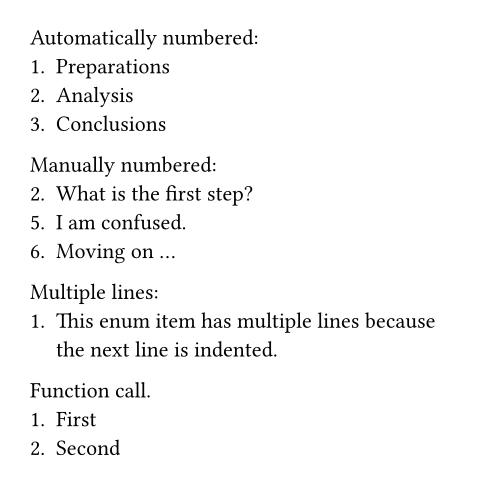
You can easily switch all your enumerations to a different numbering style with a set rule.
#set enum(numbering: "a)")
+ Starting off ...
+ Don't forget step two

You can also use enum.item to programmatically customize the number of each item in the enumeration:
#enum(
enum.item(1)[First step],
enum.item(5)[Fifth step],
enum.item(10)[Tenth step]
)

Syntax
This functions also has dedicated syntax:
- Starting a line with a plus sign creates an automatically numbered enumeration item.
- Starting a line with a number followed by a dot creates an explicitly numbered enumeration item.
Enumeration items can contain multiple paragraphs and other block-level content. All content that is indented more than an item's marker becomes part of that item.
Parameters
tight
If this is false, the items are spaced apart with enum spacing. If it is true, they use normal leading instead. This makes the enumeration more compact, which can look better if the items are short.
In markup mode, the value of this parameter is determined based on whether items are separated with a blank line. If items directly follow each other, this is set to true; if items are separated by a blank line, this is set to false.
Default: true
 View example
View example
+ If an enum has a lot of text, and
maybe other inline content, it
should not be tight anymore.
+ To make an enum wide, simply
insert a blank line between the
items.
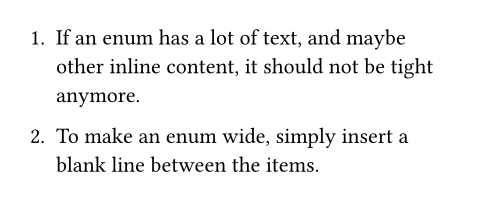
numbering
How to number the enumeration. Accepts a numbering pattern or function.
If the numbering pattern contains multiple counting symbols, they apply to nested enums. If given a function, the function receives one argument if full is false and multiple arguments if full is true.
Default: "1."
 View example
View example
#set enum(numbering: "1.a)")
+ Different
+ Numbering
+ Nested
+ Items
+ Style
#set enum(numbering: n => super[#n])
+ Superscript
+ Numbering!
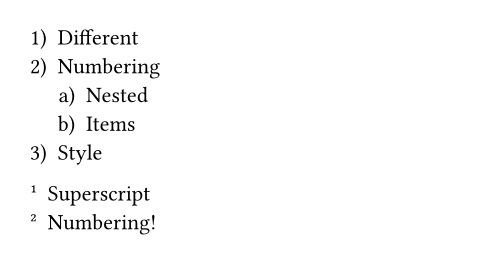
start
Which number to start the enumeration with.
Default: 1
 View example
View example
#enum(
start: 3,
[Skipping],
[Ahead],
)

full
Whether to display the full numbering, including the numbers of all parent enumerations.
Default: false
 View example
View example
#set enum(numbering: "1.a)", full: true)
+ Cook
+ Heat water
+ Add integredients
+ Eat
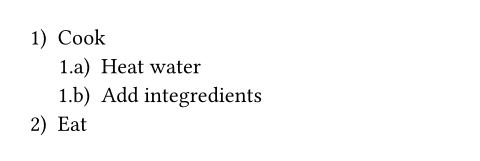
indent
The indentation of each item.
Default: 0pt
body-indent
The space between the numbering and the body of each item.
Default: 0.5em
spacing
The spacing between the items of a wide (non-tight) enumeration.
If set to auto, uses the spacing below blocks.
Default: auto
number-align
The alignment that enum numbers should have.
By default, this is set to end + top, which aligns enum numbers towards end of the current text direction (in left-to-right script, for example, this is the same as right) and at the top of the line. The choice of end for horizontal alignment of enum numbers is usually preferred over start, as numbers then grow away from the text instead of towards it, avoiding certain visual issues. This option lets you override this behaviour, however. (Also to note is that the unordered list uses a different method for this, by giving the marker content an alignment directly.).
Default: end + top
 View example
View example
#set enum(number-align: start + bottom)
Here are some powers of two:
1. One
2. Two
4. Four
8. Eight
16. Sixteen
32. Thirty two
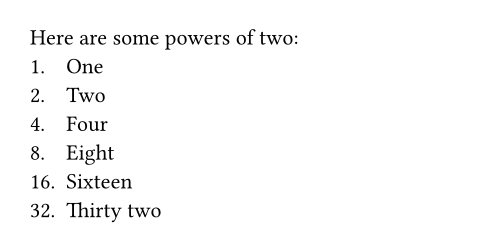
children
The numbered list's items.
When using the enum syntax, adjacent items are automatically collected into enumerations, even through constructs like for loops.
 View example
View example
#for phase in (
"Launch",
"Orbit",
"Descent",
) [+ #phase]

Definitions
itemElement
An enumeration item.
number
The item's number.
Default: none
body
The item's body.